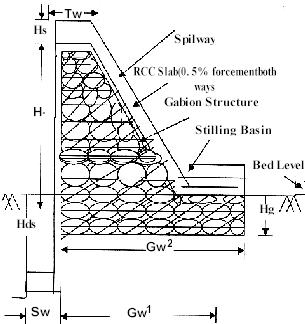LOW COST ENGINEERING STRUCTURE
Shri P. Rapthap,Assistant Soil Conservation Officer.
Soil Conservation work through engineering measures is comparatively more costly than other measures like afforestation and Agronomical measures. This factor t herefore enhance the idea to maximize the use of locally available materials and labour to reduce the cost of engineering work to serve the purpose, and attaining required strength, stability and durability.
To achieve the objective mentioned a model designed structure, as shown in figure next page, may be adopted for the construction of check/diversion/ Head water Dam if site permits and building materials is available in the vicinity.
CROSS SECTIONAL ELEVATION OF THE DAM
Brief Description of Cross-sectional detail of the Structure: -
-
Gabion Structure: - Consist of Dry stone Masonry work, strengthened with sausage wire netting (8Nos S.W.G.). This portion provide adequate mass and weight to the structure to resist the force due to lateral pressure exerts by the water standing behind the structures and flowing above the spill way during peak flow.
-
R.C.C. Slab Cover: - This portion of the Dam cross-section is to render the structure imperviousness so that the desired head can be attained for diverting water for irrigation or other purposes. The R.C.C. slab is also provides additional strength since it makes the structure to act as a combined unit by distributing any force action on it throughout the body of the structure. The R.C.C. slab foundation can be taken to greater depth as shown in drawing depending on site conditions to control seepage.
Advantages and disadvantages of this type of structure can be summed up as follows: -
Advantages: -
-
It is cheaper, costing about 0.6-0.75 times of R.C.C. or C.C. Dam of the same height if necessary building stones are available at the site of construction.
-
Unskilled and semiskilled Labour can be utilized, since the construction is very simple, thereby generating more employment opportunity for the villagers.
-
Cost of maintenance is less and simpler since C.C. work is involved than monolithic C.C. Dam.
-
The structure consisting of Gabion and R.C.C. will have more tolerance in case slight settlement occurs it will be distributed through the length of the Dam.
-
The Cross-sectional area of this type of structure being bigger, may be shaped to act as spillway for safe disposal of stream flow during peak periods.
Disadvantages: -
-
Can be adopted only if materials i.e stone are available in plenty at the site of construction.
Not Advisable to used for structure of total height more than 3.00m from foundation.The prototype of this structure designed by Shri. P. Rapthap, Assistant Soil Conservation Officer has been implemented across the Wynniar Stream in Sangriang Model Village West Khasi Hills by the Range Officer Nongstoin under the Office of the Divisional Soil Conservation Officer Nongstoin funded under the Employment Assurance Scheme 2001-2002.

Tw- Top width
Gw¹ Width of Gabion at Bed Level
Gw² Width of Gabion at Foundation Level.
Sw- Width of R.C.C. slab
Rein- Foundation.
Hs- Height of Spillway
Height of storage
Hg- Depth of Gabion
Foundation
Hds- Depth of slab foundationThe Scheme is benefited by the whole community of Sangriang village where it meet two objectives namely (i) Fisheries purposes and (ii) To supply water to a community washing and bathing place.
The Dam so constructed impounded an extra storage capacity of about 2.5. to 3.00 Ha-m of water submerging a total length of approximately 1000metres at an average width of 30 meters to an extra depth of 1 meter area, to facilitate rearing of an extra population of about 25,000 to 30,000 fishes. -
